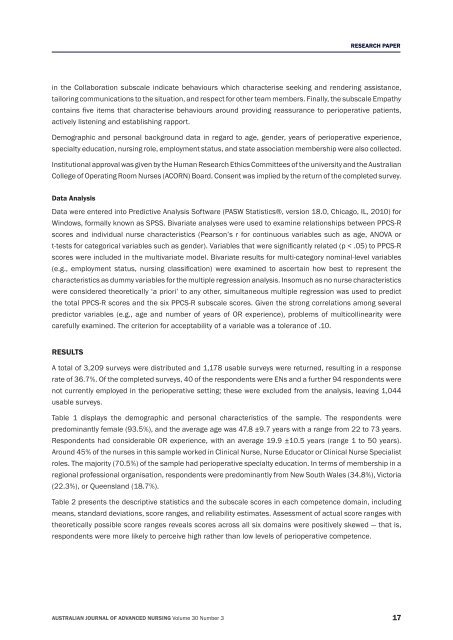Download Complete Issue - Australian Journal of Advanced Nursing
Download Complete Issue - Australian Journal of Advanced Nursing
Download Complete Issue - Australian Journal of Advanced Nursing
You also want an ePaper? Increase the reach of your titles
YUMPU automatically turns print PDFs into web optimized ePapers that Google loves.
RESEARCH PAPERin the Collaboration subscale indicate behaviours which characterise seeking and rendering assistance,tailoring communications to the situation, and respect for other team members. Finally, the subscale Empathycontains five items that characterise behaviours around providing reassurance to perioperative patients,actively listening and establishing rapport.Demographic and personal background data in regard to age, gender, years <strong>of</strong> perioperative experience,specialty education, nursing role, employment status, and state association membership were also collected.Institutional approval was given by the Human Research Ethics Committees <strong>of</strong> the university and the <strong>Australian</strong>College <strong>of</strong> Operating Room Nurses (ACORN) Board. Consent was implied by the return <strong>of</strong> the completed survey.Data AnalysisData were entered into Predictive Analysis S<strong>of</strong>tware (PASW Statistics®, version 18.0, Chicago, IL, 2010) forWindows, formally known as SPSS. Bivariate analyses were used to examine relationships between PPCS-Rscores and individual nurse characteristics (Pearson’s r for continuous variables such as age, ANOVA ort-tests for categorical variables such as gender). Variables that were significantly related (p < .05) to PPCS-Rscores were included in the multivariate model. Bivariate results for multi-category nominal-level variables(e.g., employment status, nursing classification) were examined to ascertain how best to represent thecharacteristics as dummy variables for the multiple regression analysis. Insomuch as no nurse characteristicswere considered theoretically ‘a priori’ to any other, simultaneous multiple regression was used to predictthe total PPCS-R scores and the six PPCS-R subscale scores. Given the strong correlations among severalpredictor variables (e.g., age and number <strong>of</strong> years <strong>of</strong> OR experience), problems <strong>of</strong> multicollinearity werecarefully examined. The criterion for acceptability <strong>of</strong> a variable was a tolerance <strong>of</strong> .10.RESULTSA total <strong>of</strong> 3,209 surveys were distributed and 1,178 usable surveys were returned, resulting in a responserate <strong>of</strong> 36.7%. Of the completed surveys, 40 <strong>of</strong> the respondents were ENs and a further 94 respondents werenot currently employed in the perioperative setting; these were excluded from the analysis, leaving 1,044usable surveys.Table 1 displays the demographic and personal characteristics <strong>of</strong> the sample. The respondents werepredominantly female (93.5%), and the average age was 47.8 ±9.7 years with a range from 22 to 73 years.Respondents had considerable OR experience, with an average 19.9 ±10.5 years (range 1 to 50 years).Around 45% <strong>of</strong> the nurses in this sample worked in Clinical Nurse, Nurse Educator or Clinical Nurse Specialistroles. The majority (70.5%) <strong>of</strong> the sample had perioperative specialty education. In terms <strong>of</strong> membership in aregional pr<strong>of</strong>essional organisation, respondents were predominantly from New South Wales (34.8%), Victoria(22.3%), or Queensland (18.7%).Table 2 presents the descriptive statistics and the subscale scores in each competence domain, includingmeans, standard deviations, score ranges, and reliability estimates. Assessment <strong>of</strong> actual score ranges withtheoretically possible score ranges reveals scores across all six domains were positively skewed — that is,respondents were more likely to perceive high rather than low levels <strong>of</strong> perioperative competence.AUSTRALIAN JOURNAL OF ADVANCED NURSING Volume 30 Number 3 17
















